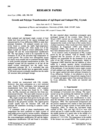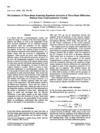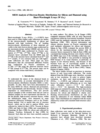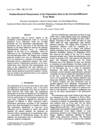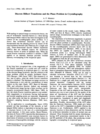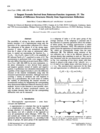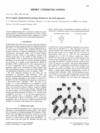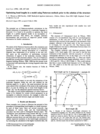issue contents
July 1996 issue

Cover illustration: Indicatrix of the inverse of Young's modulus for ADP, a tetragonal crystal. Courtesy of A. Authier, Laboratoire de Minéralogie-Cristallographie, Université Pierre et Marie Curie, Paris, France.
lead articles
A unified description is given of modulated crystals and quasicrystals based on higher-dimensional crystallography.
topical reviews
The applications of the maximum entropy and Bayesian methods to problems in X-ray, neutron and electron crystallography are reviewed.
research papers
Significant results on (a) polytype formation in undoped and AgI-doped single crystals of lead iodide and (b) polytype transformation in them on prolonged storage of several months are reported and analysed.
It is shown that, for a centrosymmetric crystal and within the range of validity of the three-beam approximation, the phases as well as the magnitudes of the three structure amplitudes can be measured uniquely and directly from the geometry of the intensity distributions in the discs of a convergent-beam diffraction pattern. Separate proofs are given in terms of Lie groups, Dirac projector operators and Bloch waves.
The electron-density distributions of silicon and diamond with high resolution were synthesized by the maximum-entropy method using short-wavelength X-rays (W Kα 1).
An experimental study is presented of the profiles backward and forward diffracted by a thin Si (111) crystal plate using synchrotron radiation.
The polarization state inside the transmitted 0 beam in the Laue case of X-ray diffraction was determined with high local resolution. Calculations according to the dynamical theory were used to explain the experimental data.
By means of discrete Hilbert transforms, the autocorrelation function (the Patterson for a single unit cell) has been incorporated into the analysis of the crystallographic phase problem.
The direct-methods solution of the difference structure of a superstructure using only the intensities of superstructure reflections is shown. This result may be relevant for determining the internal structure of reconstructed surfaces by direct methods.
A direct-methods procedure is presented for the determination of a composite crystal. The crucial step is the definition of normalized structure factors for the different reflection groups.
short communications
The derivation of novel regular three-dimensional packing with a square-pyramidal coordination polyhedron is briefly described within the local approach.
A method is described that allows the refinement of bond lengths in a partial model using Patterson-method calculations. The information has uses in fragment building prior to structure solution.


 journal menu
journal menu











